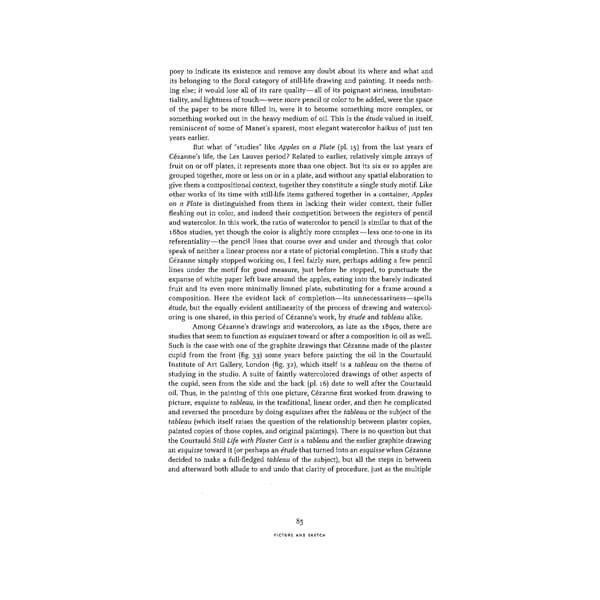posy to indicate its existence and remove any doubt about its where and what and its belonging to the floral category of still-life drawing and painting. It needs noth- ing else; it would lose all of its rare quality—all of its poignant airiness, insubstan- tiality, and lightness of touch—were more pencil or color to be added, were the space of the paper to be more filled in, were it to become something more complex, or something worked out in the heavy medium of oil. This is the étude valued in itself, reminiscent of some of Manet's sparest, most elegant watercolor haikus of just ten years earlier. But what of "studies" like Apples on a Plate (pi. 15) from the last years of Cezanne's life, the Les Lauves period? Related to earlier, relatively simple arrays of fruit on or off plates, it represents more than one object. But its six or so apples are grouped together, more or less on or in a plate, and without any spatial elaboration to give them a compositional context, together they constitute a single study motif. Like other works of its time with still-life items gathered together in a container, Apples on a Plate is distinguished from them in lacking their wider context, their fuller fleshing out in color, and indeed their competition between the registers of pencil and watercolor. In this work, the ratio of watercolor to pencil is similar to that of the i88os studies, yet though the color is slightly more complex—less one-to-one in its referentiality—the pencil lines that course over and under and through that color speak of neither a linear process nor a state of pictorial completion. This a study that Cézanne simply stopped working on, I feel fairly sure, perhaps adding a few pencil lines under the motif for good measure, just before he stopped, to punctuate the expanse of white paper left bare around the apples, eating into the barely indicated fruit and its even more minimally limned plate, substituting for a frame around a composition. Here the evident lack of completion—its unnecessariness—spells etude, but the equally evident antilinearity of the process of drawing and watercol- oring is one shared, in this period of Cezanne's work, by étude and tableau alike. Among Cezanne's drawings and watercolors, as late as the 18905, there are studies that seem to function as esquisses toward or after a composition in oil as well. Such is the case with one of the graphite drawings that Cézanne made of the plaster cupid from the front (fig. 33) some years before painting the oil in the Courtauld Institute of Art Gallery, London (fig. 32), which itself is a tableau on the theme of studying in the studio. A suite of faintly watercolored drawings of other aspects of the cupid, seen from the side and the back (pi. 16) date to well after the Courtauld oil. Thus, in the painting of this one picture, Cézanne first worked from drawing to picture, esquisse to tableau, in the traditional, linear order, and then he complicated and reversed the procedure by doing esquisses after the tableau or the subject of the tableau (which itself raises the question of the relationship between plaster copies, painted copies of those copies, and original paintings). There is no question but that the Courtauld Still Life with Plaster Cast is a tableau and the earlier graphite drawing an esquisse toward it (or perhaps an étude that turned into an esquisse when Cézanne decided to make a full-fledged tableau of the subject), but all the steps in between and afterward both allude to and undo that clarity of procedure, just as the multiple 85 PICTURE AND SKETCH
 Cézanne in the Studio: Still Life in Watercolors Page 99 Page 101
Cézanne in the Studio: Still Life in Watercolors Page 99 Page 101